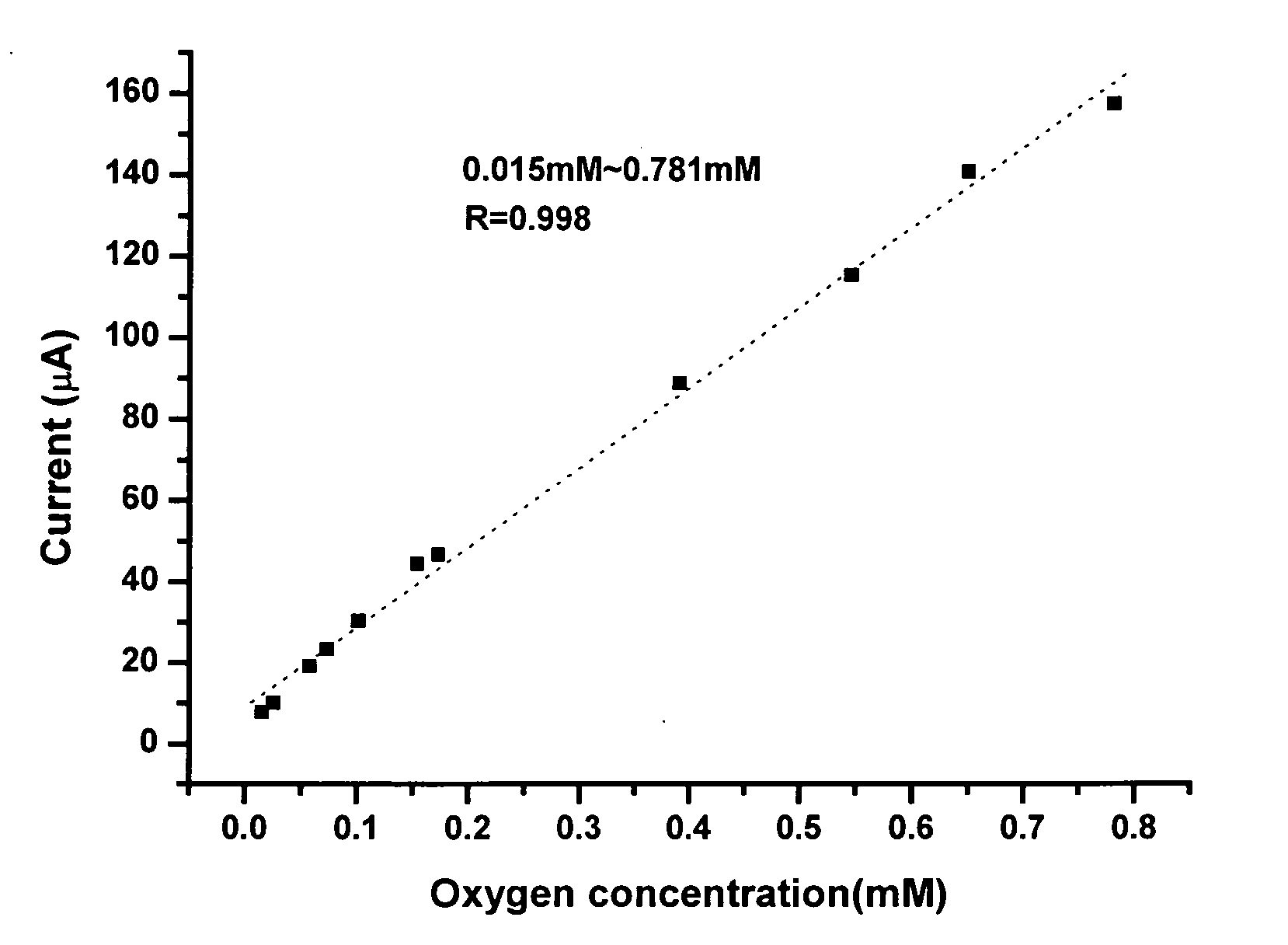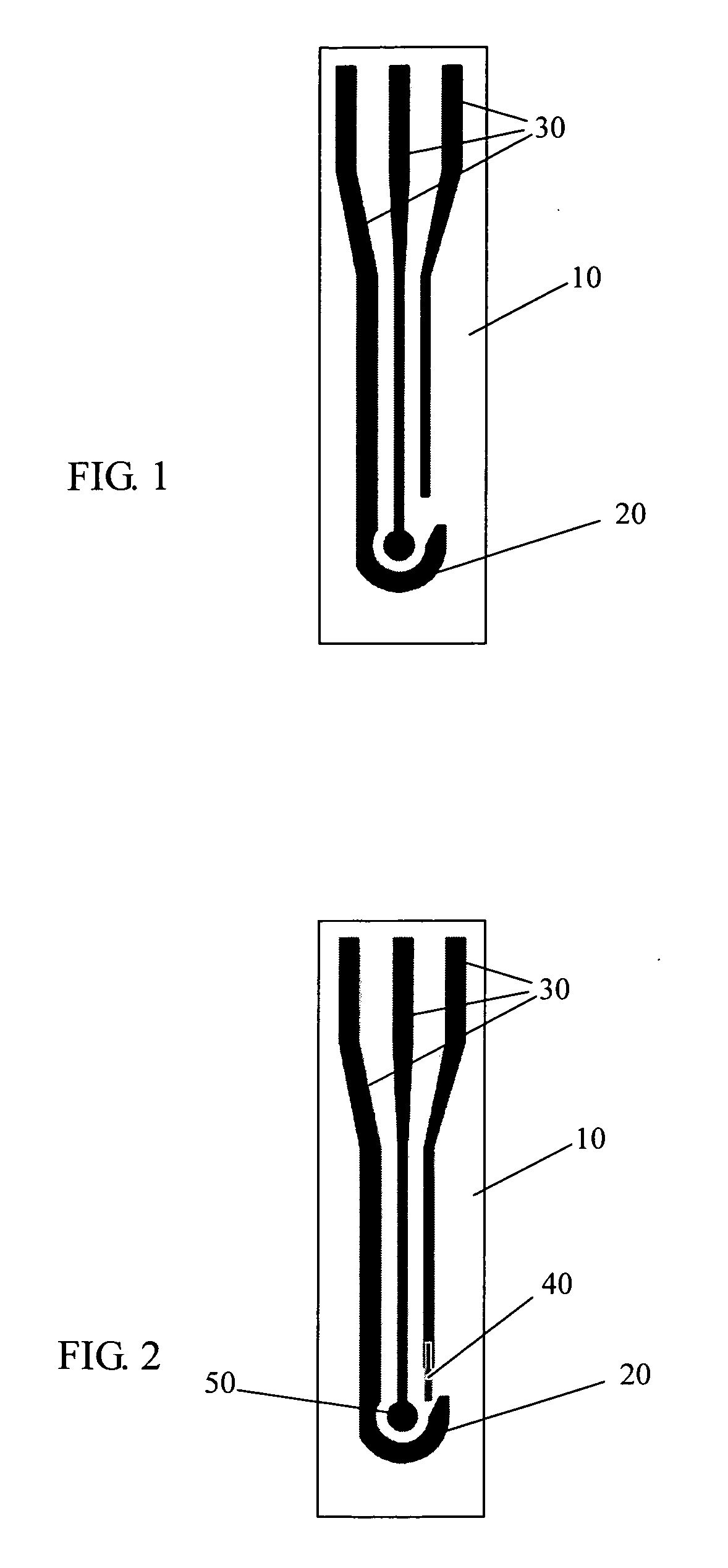Method and electrochemical sensing strip with screen-printed three electrodes for determining concentration of dissolved oxygen in a solution
a technology of dissolved oxygen and electrodes, applied in the field of electrochemical sensors, can solve the problems of long response time, increased inconvenience in operation, and increased cost of materials, and achieve the effects of low interference, high sensitivity, and high sensitivity
- Summary
- Abstract
- Description
- Claims
- Application Information
AI Technical Summary
Benefits of technology
Problems solved by technology
Method used
Image
Examples
example 1
Chemical Sensor Based on Co3O4
(1). Pretreatment of Electrode
[0042] A rotating disk graphite electrode was polished using 0.1 μm Al2O3 suspension, and sonicated for three minutes in deionized water. The procedures were repeated once. The electrode surface was then rinsed with deionized water twice. Finally, the electrode surface was checked by a cyclic voltammetry (BAS 100W, Bioanalytical Systems) to ensure free of contamination.
(2). Preparation of a Working Electrode
[0043] A mixture having 50% of Co3O4 was prepared by well mixing CO3O4 and electrically conductive ink, which was then diluted with cyclohexanone to obtain a viscosity suitable for coating (the amount of cyclohexanone added was about equal to the mixture). The pretreated rotating disk graphite electrode was coated with the resulting Co3O4 mixture, and dried at 40° C. for 20 minutes.
(3). Measurement Conditions
[0044] The working electrode prepared above, a homemade 3M KCl Ag / AgCl reference electrode, and a platinu...
example 2
Chemical Sensor Based on Cyanocobalamin (Vitamin B12)
(1). Pretreatment of Electrode
[0050] A rotating disk graphite electrode was polished using 0.1 μm Al2O3 suspension, and sonicated for three minutes in deionized water. The procedures were repeated once. The electrode surface was then rinsed with deionized water twice. Finally, the electrode surface was checked by a cyclic voltammetry (BAS 100W, Bioanalytical Systems) to ensure free of contamination.
(2). Preparation of a Working Electrode
[0051] A mixture having 15 parts by weight of cyanocobalamin and 45 parts by weight of electrically conductive ink was prepared, and was then diluted with 40 parts by weight of cyclohexanone to obtain a viscosity suitable for coating. The pretreated rotating disk graphite electrode was coated with 3 μL of the resulting cyanocobalamin mixture, and dried at 25° C. for 30 minutes, followed by immersing in 0.05 M phosphate buffer (pH=6) for 25 minutes for stabilization while stirring at 625 rpm. ...
example 3
Chemical Sensor Based on Cobalt (II) Phthalocyanine
(1). Pretreatment of Electrode
[0058] A rotating disk graphite electrode was polished using 0.1 μm Al2O3 suspension, and sonicated for three minutes in deionized water. The procedures were repeated once. The electrode surface was then rinsed with deionized water twice. Finally, the electrode surface was checked by a cyclic voltammetry (BAS 100W, Bioanalytical Systems) to ensure free of contamination.
(2). Preparation of a Working Electrode
[0059] A mixture having 20% of cobalt (II) phthalocyanine was prepared by well mixing cobalt (II) phthalocyanine and electrically conductive ink, which was then diluted with cyclohexanone to obtain a viscosity suitable for coating (the amount of cyclohexanone added was about equal to the mixture). The pretreated rotating disk graphite electrode was coated with the resulting cobalt (II) phthalocyanine mixture, and dried at 30° C. for 30 minutes.
(3). Measurement Conditions
[0060] The working el...
PUM
 Login to View More
Login to View More Abstract
Description
Claims
Application Information
 Login to View More
Login to View More - R&D
- Intellectual Property
- Life Sciences
- Materials
- Tech Scout
- Unparalleled Data Quality
- Higher Quality Content
- 60% Fewer Hallucinations
Browse by: Latest US Patents, China's latest patents, Technical Efficacy Thesaurus, Application Domain, Technology Topic, Popular Technical Reports.
© 2025 PatSnap. All rights reserved.Legal|Privacy policy|Modern Slavery Act Transparency Statement|Sitemap|About US| Contact US: help@patsnap.com



